NYC Museums: The Frick Collection
A Gilded Age Mansion Turned Art Museum In NYC
Spring 2014 / NYC Neighborhoods / Art & Culture NYC / Gotham Buzz NYC.
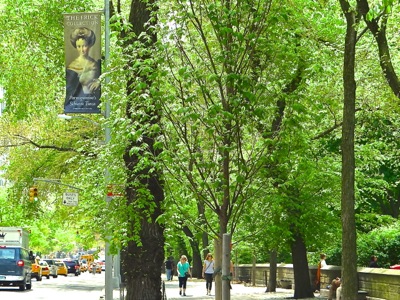 A year ago I had the opportunity to attend the opening presentation of a new arrival at The Frick Collection on the Upper East Side of Manhattan. It was a beautiful May day as I walked north along the east side of Central Park. I noticed banners hanging from the street lights on Fifth Avenue announcing the opening of the new art exhibit at The Frick Collection.
A year ago I had the opportunity to attend the opening presentation of a new arrival at The Frick Collection on the Upper East Side of Manhattan. It was a beautiful May day as I walked north along the east side of Central Park. I noticed banners hanging from the street lights on Fifth Avenue announcing the opening of the new art exhibit at The Frick Collection.
The museum was once the home of Henry Clay Frick. Henry Frick grew up in southwestern Pennsylvania in the middle of the 19th century. By the time Frick was thirty he and his cousins had cornered the lion's share of the coke business in the state of Pennsylvania. Coke was made by burning off the unstable elements in coal, thus making it a reliable high-intensity fuel that was relatively abundant and inexpensive to produce. In the 19th century coke was used to fuel the blast furnaces of the steel mills, a practice which continues to this day in many steel plants around the world.
The Frick Collection: History Of Henry Clay Frick
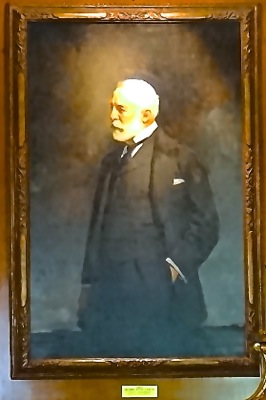 In the early 1880's Henry Clay Frick's coke company joined Andrew Carnegie's steel company. The merged companies became a vertically integrated enterprise which subsequently provided Frick's coke company with a steady buyer of its product, and provided Carnegie's steel company with a steady source of fuel. Together these enterprises grew rapidly, and in the process made Frick and Carnegie, two of the wealthiest men in America.
In the early 1880's Henry Clay Frick's coke company joined Andrew Carnegie's steel company. The merged companies became a vertically integrated enterprise which subsequently provided Frick's coke company with a steady buyer of its product, and provided Carnegie's steel company with a steady source of fuel. Together these enterprises grew rapidly, and in the process made Frick and Carnegie, two of the wealthiest men in America.
Both the coke and steel industries had employment issues related to working conditions, fair pay and health hazards. The unions attempted to organize their labor forces and were beaten back by the joint enterprise of the Frick Coke Company and the Carnegie Steel Company, lead by Henry Clay Frick. Frick oversaw the effort to thwart them, meeting force with force. Several men died in the clash and henceforth Frick has been vilified as one of the 19th century, industrialist robber barons. But Frick is not alone as one of the robber barons, as the likes of his cohort Andrew Carnegie [steel], J.P. Morgan [banking], John D. Rockefeller [oil] and Jay Gould [banking] are just a few of those who are included in this category.
In 1911, J.P. Morgan finessed a deal that merged together the Carnegie Steel Company, with several other enterprises, into what became U.S. Steel. U.S. Steel was, in the early 20th century, one of the largest corporations in America, and at its peak controlled nearly two thirds of American steel production. It's important to add that this was at a time when steel was growing as one of the essential building materials of its time, as it was being used to build trains, railroads, ships, electrical generators and beginning to be used in new inventions like automobiles, elevators, high rise construction [Flatiron Building], appliances [telephones] and as shipping containers [cans] for consumer products.
Upper East Side: Once Home To Robber Barons
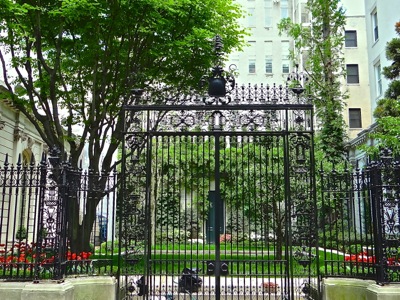 Many of the robber barons lived in Manhattan along Fifth Avenue in what is today called the Midtown and the Upper East Side neighborhoods. The robber barons gave some portion of their considerable wealth back to the communities in the form of art [Frick], education [John D. Rockefeller bankrolled the University of Chicago], art & history [J.P. Morgan to the Metropolitan Museum and his home is the Morgan Library & Museum] and libraries [Andrew Carnegie gifts helped start about half the public libraries in the U.S.].
Many of the robber barons lived in Manhattan along Fifth Avenue in what is today called the Midtown and the Upper East Side neighborhoods. The robber barons gave some portion of their considerable wealth back to the communities in the form of art [Frick], education [John D. Rockefeller bankrolled the University of Chicago], art & history [J.P. Morgan to the Metropolitan Museum and his home is the Morgan Library & Museum] and libraries [Andrew Carnegie gifts helped start about half the public libraries in the U.S.].
Carnegie is the most notable philanthropist, as he gave nearly all of his $300 million wealth away [equivalent of tens of billions and likely more today] before he died. And Jay Gould is most notable in the other extreme, as he's reputed to not have given a dime back to the community. But that said, it's worth noting that one of Jay Gould's heirs subsequently donated Lyndhurst Mansion in Tarrytown to the National Historic Trust. But I digress.
Frick had a taste for art and objets d'art. From the beginning of his economic ascendance he began collecting. And as his wealth grew, he began acquiring many of the world's artistic and aesthetic treasures. Before he died, he bequeathed some of his wealth to the communities of western Pennsylvania in the form of the mansions he built and / or lived in, along with many of the fine art, furniture and objets d'art he had purchased during his lifetime. Western Pennsylvania and Pittsburgh are home to much of what Frisk left the public.
Click here to read the rest of our report about The Frick Collection / Frick Museum / Frick Mansion - Robber Baron Mansions on the Upper East Side NYC.
NYC Museums: The Frick Collection
A Gilded Age Mansion Turned Art Museum In NYC
Spring 2014 / NYC Neighborhoods / Art & Culture NYC / Gotham Buzz NYC. Continued.
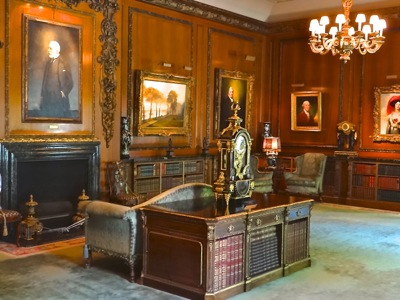 I arrived before the presentation of Parmigiano's Schiava Turca was to begin. I had an opportunity to relax in the enclosed Garden Court. The Garden Court was part of the Frick Mansion when it first opened to the public in 1935 [see photo below right].
I arrived before the presentation of Parmigiano's Schiava Turca was to begin. I had an opportunity to relax in the enclosed Garden Court. The Garden Court was part of the Frick Mansion when it first opened to the public in 1935 [see photo below right].
Henry Clay Frick spent most of the first fifty years of his life managing the business of Frick Coke Company and subsequently the Carnegie Steel Company. After the turn of the 20th century, and only years before the time of the transformation of the Carnegie Steel Corporation into U.S. Steel [1911], Frick and his wife moved to New York City [1901 - 1905]. Frick commissioned the building of the Frick Mansion along Fifth Avenue, and he and his wife moved into it in 1914. At the time he made plans to bequeath the mansion and its contents to the public as a museum, following his wife's death [1931].
UES: Enclosed Garden In The Frick Mansion
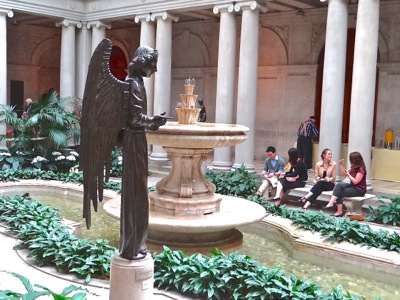 I sat down to enjoy the enclosed garden. There's a marble fountain standing in the center of it, from which water gently flows, providing a soothing acoustical ambience. It allowed me to leave the noisy, busy, 21st century city streets behind.
I sat down to enjoy the enclosed garden. There's a marble fountain standing in the center of it, from which water gently flows, providing a soothing acoustical ambience. It allowed me to leave the noisy, busy, 21st century city streets behind.
There are a number of bronze and marble statues in and around the garden. Some quietly sit in alcoves along the walled perimeter, while others carefully stand on pedestals overlooking the visitors. I felt as if I had entered another world ... and in fact ... I had. I had just entered into - the world of art and collectibles.
NYC Art Museums: The Frick Collection
In time, after bathing in the ambient light and sound of the garden, the agitation of daily life fell off of me. I started moving again, making my way into the Oval Room, where we would be introduced to one of the celebrated European guests to the Frick Collection - Parmigianino's Schiava Turca. Parmigianino's Schiava Turca [translates to Turkish Slave] was on loan from the Galleria Nazionale di Parma, along with another painting by Francesco Mazzola from a private collection entitled Portrait of a Man [Mazzola's nickname was Parmigianino as he was from Parma].
Art Imitates Life: 16th Century Oil Portraits Social
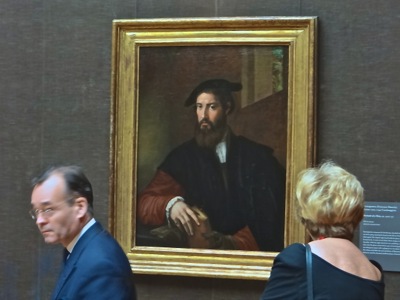 Already a number of the lady's [Parmigianino's Schiava Turca] fans had arrived. I found myself milling around with them, but eventually turned my attention to what one might call the 'locals' of portrait celebrities. The 'locals' [locally owned by the Frick] included Titian's Pietro Aretino, Titian's Portrait of a Man in a Red Cap, and Bronzino's Lodovico Capponi . As mentioned above, there was also a second guest portrait by Parmigianino on loan from a private collection, entitled Portrait of a Man [in photo at right].
Already a number of the lady's [Parmigianino's Schiava Turca] fans had arrived. I found myself milling around with them, but eventually turned my attention to what one might call the 'locals' of portrait celebrities. The 'locals' [locally owned by the Frick] included Titian's Pietro Aretino, Titian's Portrait of a Man in a Red Cap, and Bronzino's Lodovico Capponi . As mentioned above, there was also a second guest portrait by Parmigianino on loan from a private collection, entitled Portrait of a Man [in photo at right].
The Oval Room At The Frick Collection: Centuries Old Art Up Close
It is here in the Oval Room that the Parmigianino paintings made their first visit to the new world - more than half a millenia after America had been discovered by Columbus in 1492. These paintings were all mastered within only a few decades of the New World discovery, having been painted between 1516 and 1537. During this time the Schiava Turca had moved around and in the process the painting had picked up its name. But Guest Curator Aimee Ng asked us was this Madonna-like woman really a Turkish Slave? The Schiava Turca posed enigmatically, and in some measure, in a manner similar in kind to that of the Mona Lisa [see portrait in photo below right].
Aimee Ng, Curator, Takes Us On A Journey Through Time
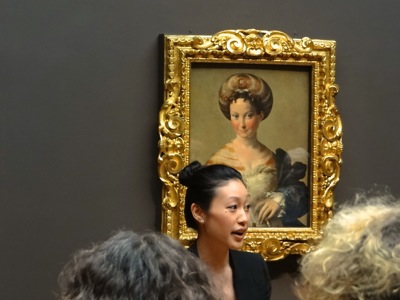 Aimee Ng [shown speaking in photo at right] provided some fresh insights into the work. Aimee's discourse took us back five hundred years in time to Parma, Italy which is located in north central Italy. During the 16th century Francesco Mazzola, called Il Parmigianino, was one of the premier painters of his time. Some compared Parmigianino to Raphael of Urbino, who was an older painter, but the two lives overlapped contemporaneously. Parmigianino captured the visages of many of the people of his time, and implicit in the portraits were multiple embedded stories. Embedded stories, the details of which, Aimee had researched and brought to light.
Aimee Ng [shown speaking in photo at right] provided some fresh insights into the work. Aimee's discourse took us back five hundred years in time to Parma, Italy which is located in north central Italy. During the 16th century Francesco Mazzola, called Il Parmigianino, was one of the premier painters of his time. Some compared Parmigianino to Raphael of Urbino, who was an older painter, but the two lives overlapped contemporaneously. Parmigianino captured the visages of many of the people of his time, and implicit in the portraits were multiple embedded stories. Embedded stories, the details of which, Aimee had researched and brought to light.
Aimee took us on a voyage back through time into the life of Parmigianino's portrait. She talked about clues buried in the oil of the paint, like the Schiava Turca's head covering and clasp, hair, garments and pose. Aimee had gone back into the period looking for contextual clues in search of the true identity of the woman in the painting, as it appears the name acquired over time by the painting - Turkish Slave - is incongruous with the image.
Aimee concluded her talk, summarizing reasonable arguments that could be made for questioning whether the woman in the painting was really a Turkish Slave. Was she an artist? Or poet? As Aimee concluded her talk, she invited us to observe the great detail of the other great paintings in the room, of the 'locals' [locally owned by the Frick] painted by Titian and Bronzino that Henry Clay Frick had taken great care to acquire and preserve. Thus, for the duration of the exhibit, visitors to The Frick Collection would be able to see a couple of works by Parmigianino in public in America for the first time - hanging alongside the works of several of his contemporaries.
Ian Wardropper, Director: The Frick Collection Charm Is Its Intimacy
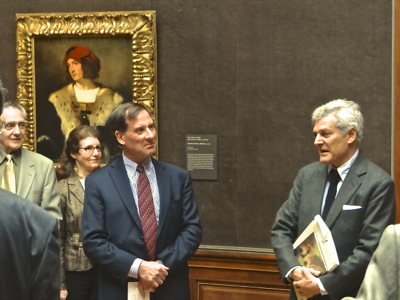 Ian Wardropper, Director of The Frick Collection, told me that this is the beauty and unique attraction of the Frick Collection. He said that the Frick Mansion provides visitors with an opportunity to view a select curation of some of the great classical European works in a personal and almost intimate setting. Ian Wardropper is shown standing front & middle in the photo at right.
Ian Wardropper, Director of The Frick Collection, told me that this is the beauty and unique attraction of the Frick Collection. He said that the Frick Mansion provides visitors with an opportunity to view a select curation of some of the great classical European works in a personal and almost intimate setting. Ian Wardropper is shown standing front & middle in the photo at right.
He went on to say that this is one of the characteristics that distinguishes the Frick Collection from the other great art museums in the city, nation and world. Here one can view centuries old oil paintings like the Schiava Turca alongside the portraits of other great masters of the time - the masterful works of the time - which are also a part of the Frick Collection. And through Frick Collection programs, one can learn some of the important details about these great works, that one might be hard pressed to find almost anywhere else.
Manhattan Museums: Enlightenment & Beauty Sculptures
At the time of my visit there was an exhibit entitled Enlightenment and Beauty, which contained statues and terra cottas by Houdon and Clodion. There's a video on The Frick Collection website that does a sublime job of introducing the exhibit. To view the Houdon and Clodion sculptures video, as well a video from cinematic reels of the Frick family, go to frick.org / interact and scroll down to the videos at the bottom of the page. This exhibit was located in the Portico.
Floor Plan: The Frick Mansion On The Upper East Side
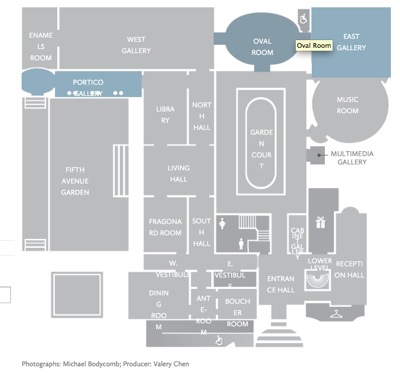 I have provided a floor plan of The Frick Mansion for you to peruse at right. Following the presentation I made my way into the Portico, which is a window lined hallway overlooking the front garden [just under and along the West Gallery on the map]. This is where If found the Enlightenment and Beauty sculpture exhibit mentioned above.
I have provided a floor plan of The Frick Mansion for you to peruse at right. Following the presentation I made my way into the Portico, which is a window lined hallway overlooking the front garden [just under and along the West Gallery on the map]. This is where If found the Enlightenment and Beauty sculpture exhibit mentioned above.
I then walked south through the Library, the Living Hall and the Fragonard Room. I had arranged to obtain a press pass with permission to shoot non-flash photos and to publish them which is not generally allowed to the public.
The West and East Galleries were cordoned off, so while I looked into them, I could only see glimpses of them in the background of photos I shot in the Oval Room. I also did not visit the Music Room nor the Frick Art Reference Library, as I believe these were not available at the time I was there.
Mansions & Museums In Manhattan: The Frick On The UES
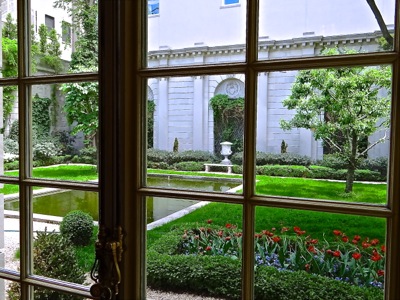 As I went to pick up my coat, I looked out onto the garden that's visible along 70th Street, and shot a photo of it. My only regret is that I did not have more time. It was truly a peaceful, transcendant visit. For a few hours, I was a guest in the Frick Mansion. For a few hours I communed with the high art and culture of America's European ancestry.
As I went to pick up my coat, I looked out onto the garden that's visible along 70th Street, and shot a photo of it. My only regret is that I did not have more time. It was truly a peaceful, transcendant visit. For a few hours, I was a guest in the Frick Mansion. For a few hours I communed with the high art and culture of America's European ancestry.
A visit to the Frick Museum provides one with the rare experience of absorbing the confluence of the cosmos. The Frick Collection is housed in one of the later mansions of the Gilded Age, and hence a visit to the Frick enables one to encounter the incredible wealth of the American 19th century dream-making-money-machine from the perspective of its transatlantic bounty of European high culture. The Frick Museum is an urban mecca that contains and preserves a collection of antiquities that historically reflect the sensibilities of a turn-of-the-century, self-made, multi-millionaire, American tycoon. And he has made these visual treats, along with the splendid ambience of his mansion home, available to all. The photo above right shows the garden off 70th Street on the Upper East Side of Manhattan.
The Frick Org Website: A Treasure Unto Itself
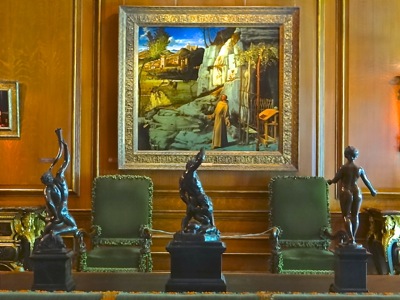 When I returned to the office I started looking for more information about the Fricks and the Frick Collection. Ian Wardropper, Frick Collection Director, had told me that they had a very interesting and informative site. I had been on the site to obtain contact information and hadn't spent the time to take notice. Besides, everyone tells me that about their site [that it's interesting].
When I returned to the office I started looking for more information about the Fricks and the Frick Collection. Ian Wardropper, Frick Collection Director, had told me that they had a very interesting and informative site. I had been on the site to obtain contact information and hadn't spent the time to take notice. Besides, everyone tells me that about their site [that it's interesting].
Nonetheless, per Ian's advice, I decided to take a second look. As I began to more thoroughly peruse the Frick website, I found myself silently thanking Ian for directing my attention back toward it. I had to click around a little bit to find the areas to match my interests, but it was there.
One of the things I found on their website [same page as the Houdon & Clodion video referenced above] was a video entitled Chatsworth and Waddesdon [British art collections]. The video is an hour long show where two heirs of great English collections, talk about their family history and the business of cultural collecting. During the program, one of the speakers remarked that part of the reason we still have many of the treasures of the past is because the wealthy patrons of the arts not only made them possible by sponsoring great artworks, but also because they collected and preserved them. In both cases, these once great private collections, are now available and possibly in part funded by, the public.
I found this something to think about. While many museums show artifacts hundreds to thousands of years old, many of the great European and American national museums are relatively new. For example the Metropolitan Museum was founded about a century and a half ago [1870], the Louvre was founded a bit over two centuries ago [1793] and the British Museum was founded a bit over two and a half centuries ago [1753]. The Louvre is the most visited museum in the world attracting 9.3 million visitors in 2013, while the British Museum is the second most visited museum attracting 6.7 million visitors in 2013 and the Metropolitan Museum is in the top ten and attracted 6.2 million visitors in 2013. By comparison Chatsworth attracted 1 million visitors, Waddesdon attracted 400,000 visitors and the Frick Collection attracted 400,000 visitors in 2013.
The Frick Collection & Programs: On The Upper East Side
 Anyhow, there it was. The end of a beautiful, and in part, inspiring day. It's worth mentioning that the Frick Collection, which is frequently called the Frick Museum [like Grand Central Terminal is called Grand Central Station] hosts a number of arts lectures and educational programs, like the one about Chatsworth and Waddesdon [both sites within a few hours of London].
Anyhow, there it was. The end of a beautiful, and in part, inspiring day. It's worth mentioning that the Frick Collection, which is frequently called the Frick Museum [like Grand Central Terminal is called Grand Central Station] hosts a number of arts lectures and educational programs, like the one about Chatsworth and Waddesdon [both sites within a few hours of London].
It's also worth mentioning that they have an art library [which I did not see] and offer monthly classical music performances in the music room [didn't see this room either]. We include some of these events in our post of weekend things to do in Manhattan. There are also other programs, including a garden event they hosted just last year to celebrate the 100th anniversary of the mansion.
The Poetry of Parmigianino: Schiava Turca exhibit was a collaboration with the Foundation for Italian Art and Culture. Many thanks to The Frick Collection, Director Ian Wardropper and curator Aimee Ng for their work in presenting this exhibit to the public. The photo above right shows the Portico overlooking the Fifth Avenue walled garden.
Upper West Side NYC - Manhattan Related Info
Click this link for promotions, discounts and coupons in Manhattan.
Upper West Side Neighborhood Related Links - NYC
Click for Manhattan Restaurants
Click for Manhattan Things To Do
Click for Gramercy Park Restaurants
Click for New Years Parties & Restaurants
Click for Manhattan Farmers Markets
Archives - TBD
Site Search Tips. 1) For best results, when typing in more than one word, use quotation marks - eg "Astoria Park". 2) Also try either singular or plural words when searching for a specific item such as "gym" or "gyms".
$element(bwcore,insert_search,N)$
Click this link to search for something in our Manhattan Business Directory.
Click the log in link below to create an ID and post an opinion.
Or send this story to a friend by filling in the appropriate box below.












